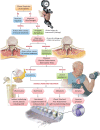Sarcopenia and Cardiovascular Diseases
- PMID: 37186680
- PMCID: PMC10180053
- DOI: 10.1161/CIRCULATIONAHA.123.064071
Sarcopenia and Cardiovascular Diseases
Abstract
Sarcopenia is the loss of muscle strength, mass, and function, which is often exacerbated by chronic comorbidities including cardiovascular diseases, chronic kidney disease, and cancer. Sarcopenia is associated with faster progression of cardiovascular diseases and higher risk of mortality, falls, and reduced quality of life, particularly among older adults. Although the pathophysiologic mechanisms are complex, the broad underlying cause of sarcopenia includes an imbalance between anabolic and catabolic muscle homeostasis with or without neuronal degeneration. The intrinsic molecular mechanisms of aging, chronic illness, malnutrition, and immobility are associated with the development of sarcopenia. Screening and testing for sarcopenia may be particularly important among those with chronic disease states. Early recognition of sarcopenia is important because it can provide an opportunity for interventions to reverse or delay the progression of muscle disorder, which may ultimately impact cardiovascular outcomes. Relying on body mass index is not useful for screening because many patients will have sarcopenic obesity, a particularly important phenotype among older cardiac patients. In this review, we aimed to: (1) provide a definition of sarcopenia within the context of muscle wasting disorders; (2) summarize the associations between sarcopenia and different cardiovascular diseases; (3) highlight an approach for a diagnostic evaluation; (4) discuss management strategies for sarcopenia; and (5) outline key gaps in knowledge with implications for the future of the field.
Keywords: body mass index; cardiovascular diseases; older adults; sarcopenia.
Conflict of interest statement
Figures


References
-
- He W, Sengupta M, Velkoff V, DeBarros K. In; 65+ in the United States: 2005, Current Population Reports. 2005:P23–209. Accessed April 28, 2023. https://www.census.gov/content/dam/Census/library/publications/2005/demo...
-
- Damluji AA, Forman DE, van Diepen S, Alexander KP, Page RL, Hummel SL, Menon V, Katz JN, Albert NM, Afilalo J, et al. ; American Heart Association Council on Clinical Cardiology and Council on Cardiovascular and Stroke Nursing. Older adults in the cardiac intensive care unit: factoring geriatric syndromes in the management, prognosis, and process of care: a scientific statement from the American Heart Association. Circulation. 2020;141:e6–e32. doi: 10.1161/CIR.0000000000000741 - PubMed
-
- Damluji AA, Forman DE, Wang TY, Chikwe J, Kunadian V, Rich MW, Young BA, Page RL, DeVon HA, Alexander KP; American Heart Association Cardiovascular Disease in Older Populations Committee of the Council on Clinical Cardiology and Council on Cardiovascular and Stroke Nursing; Council on Cardiovascular Radiology and Intervention; and Council on Lifestyle and Cardiometabolic Health. Management of acute coronary syndrome in the older adult population: a scientific statement from the American Heart Association. Circulation. 2023;147:e32–e62. doi: 10.1161/CIR.0000000000001112 - PMC - PubMed
-
- Gao K, Cao LF, Ma WZ, Gao YJ, Luo MS, Zhu J, Li T, Zhou D. Association between sarcopenia and cardiovascular disease among middle-aged and older adults: findings from the China health and retirement longitudinal study. EClinicalMedicine. 2022;44:101264. doi: 10.1016/j.eclinm.2021.101264 - PMC - PubMed
Publication types
MeSH terms
Grants and funding
- R01 AG078153/AG/NIA NIH HHS/United States
- R01 AG060499/AG/NIA NIH HHS/United States
- U19 AG065188/AG/NIA NIH HHS/United States
- K23 HL153771/HL/NHLBI NIH HHS/United States
- P30 AG021334/AG/NIA NIH HHS/United States
- R21 AG070804/AG/NIA NIH HHS/United States
- R01 CA246695/CA/NCI NIH HHS/United States
- R01 AG066671/AG/NIA NIH HHS/United States
- I21 RX004409/RX/RRD VA/United States
- P30 AG024827/AG/NIA NIH HHS/United States
- R01 AG077179/AG/NIA NIH HHS/United States
- R01 AG073633/AG/NIA NIH HHS/United States
- U19 AG065188/AG/NIA NIH HHS/United States
- R01 AG060499/AG/NIA NIH HHS/United States
- R01 AG058883/AG/NIA NIH HHS/United States
- K76 AG064428/AG/NIA NIH HHS/United States
LinkOut - more resources
Full Text Sources
Medical

